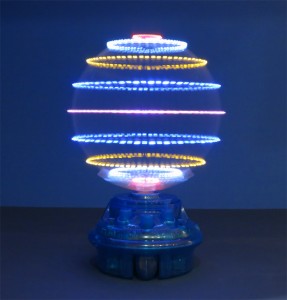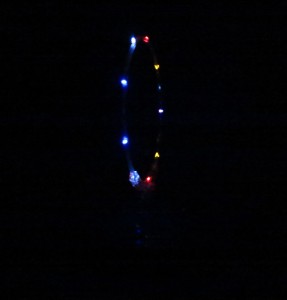Today I tried out a new gadget that I hope will be useful for demonstrating the effects of different shutter speeds for stopping action. I set up my Canon PowerShot S100 on a sturdy tripod in Shutter Priority mode and aimed at the new gizmo, which is called the Super-Sized Light Doodler. (I got mine from Edmund Scientifics.) I haven’t yet explored all of the features of this device, but, as you can see in the first image below, it consists of a blue base with a ring attached to it. The ring has a series of colored lights spaced around its rim. When you turn on the machine, the ring rotates rapidly, and the lights flash in various patterns that you can change with dials.
I turned the Light Doodler on, and what I saw was basically what you see in the second image, which was taken at 0.3 second. At that slow shutter speed, the image shows at least one full cycle of the ring, which paints a circular pattern, appearing to create a globe in mid-air. After that shot, the other shots were in the following sequence: 1/10 second, 1/25 second, 1/60 second, 1/80 second, 1/200 second, 1/1000 second, and, finally, 1/2000 second, the fastest shutter speed available on the PowerShot S100.
There isn’t all that much to conclude from this experiment. I just think it can be interesting to see how the camera, with its series of increasingly fast shutter speeds, can stop the action of an object like the rapidly-spinning ring of the Light Doodler, and make images that look like completely different objects depending on what shutter speed was used. You don’t really see what the human eye sees in this case until the shutter speed is slowed down to almost half a second.














